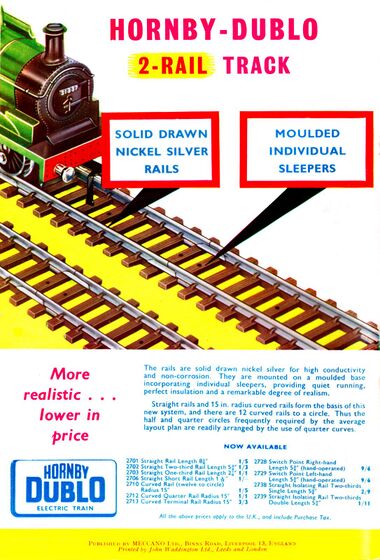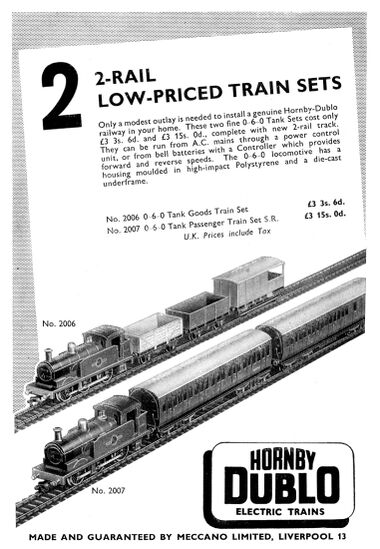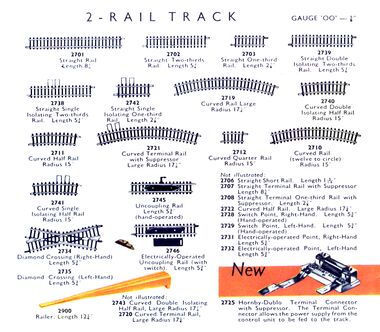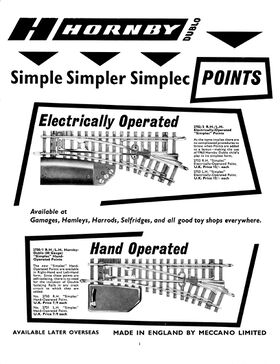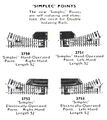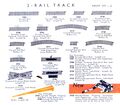Category:Hornby Dublo two-rail system
1960: Page promoting Hornby-Dublo two-rail – "More realistic ... lower in price" [image info]
1960: Dublo Low-Priced Train Sets No.2006, No.2007 [image info]
1963: Hornby-Dublo two-rail track [image info]
1963: Hornby Dublo "Simplec" points [image info]
As the 1950s progressed, it was becoming ever-clearer that one of the things that made it difficult for Dublo to compete with other cheaper systems was its clunky, "indestructable", overengineered three-rail track.
The Dublo three-rail system had, like Marklin's counterpart, been based on metal based made of bent sheet to produce a raised track-bad, with heavy clip-together connectors, and very solid rails. The system was advertised as built to last a lifetime, and its not unreasonable when finding a box of Dublo track that hasn't been touched for fifty years, to clip it together, and expect it to work first time.
Two-rail advantages
Despite its quality, the three-rail system was too expensive for casual or first-time buyers (or for parents who just wanted a basic train set to put under the Christmas tree), and for serious owners who wanted to build large and complex layouts, the cost of the track was a significant factor. For established users with permanent layouts, the need for idiot-proof "snap-together" track was less obvious, and for modellers who wanted to produce accurate-looking, almost photorealistic model railway layouts, the clunky lithographed (and slightly toyish-looking) Dublo three-rail system wasn't going to do the job, unless you buried it in modelling clay or felt.
With Triang producing simple two-rail track consisting of a simple pair of metal rails held together with plastic sleepers, with a clip on each rail to allow them to clip together, the cost was far lower, and Meccano Ltd. felt that they had to be able to be more price-competitive. the new track was "wobbly compared to the rigid metal-bedded system, but this didn't matter so much it it was going to be nailed to a plywood model railway layout base, and the visual appearance of the cheaper system was more authentic. the cheap plastic-looking sleepers could be presented as representing creosoted wood, and if anyone really found their appearance that offensive, they could always paint the sleepers and/or cover them over with miniature gravel.
There were problems implementing a three-rail system on such cheap track, as a three-rail system needed to be able to deal with a pickup being dragged long the centre conductor, and with three rails, warpage could be problematic. But with a two-rail system, the two rails were always inline no matter how one twisted the track, you only had to get good connections for two rails rather then three, and you only used two-thirds as much metal per track section.
Reception of two-rail
The response of many of Meccano Ltd.'s diehard model railway users to the new system was not one of unmitigated glee. Used to the over-engineered "Rolls-Royce" three-rail system, the new system looked a bit cheap, even if it did look more like real track, and avoided the historical anomaly of model steam locomotives running on track with a central electrical third rail. There were certain sorts of track layout that simply didn't work with two-rail – with three-rail, one could set up a tear-drop shaped loop of track that resulted in a train reaching the end of a straight section of track, traversing the loop and then coming back along the same "straight" in the opposite direction. This didn't work with two-rail DC control, as putting the loco on the same section of track pointing in the outer direction meant that its power supply polarity was reversed, making it want to run backwards.
Two-rail also made some of the electrical connections more difficult, as in certain layouts it was possible to short-circuit the two outside rails - with three-rail this hadn't been a problem, as the two outer rails were shorted by default anyway, and one couldn't accidentally connect the centre rail to either of the outer rails. Two-rail made electrical points more difficult, and sometimes required special insulating additional sections of rail, which then spoiled the dimensions of the track unless one added matching short sections of track to other areas.
The two-rail system was also more prone to dirty track and bad connections – with two-rail, the loco wheels were continually rolling over dust and dirt that settled on the rails, and could end up creating an insulating "skin" on the wheels or rails. With three-rail, a connection failure on either of the two rails didn't matter as long as the other outer rail was making a good connection, and the centre rail, which had a "scraped" rather than "rolled" pickup, was to some extent self-cleaning.
Simplec points
Meccano Ltd addressed the difficulties that some of their users were having with points-shorting issues by bringing out a new design, "Simplec", in ~1963. "Simplec" points were self-isolating, and didn't need an extra piece of isolator track to stop some layout configurations shorting out the power.
The transition to two-rail
The company's attempt to migrate their userbase from three-rail to two- was not easy, and some three-rail fans blame the failure of Meccano Ltd on the change to two-rail (although there were clearly other issues involved, both within the company and in the industry as a whole, as evidenced by Lines Brother's failure a few years later).
Transitioning the rolling stock was comparatively easy, once the company had produced a design with insulated axles, there was no obvious reason not to implement it on every piece of rolling stock that the company produced, so the switch to two-rail compatible wagons and carriages happened some time before the implementation of two-rail.
The situation with other items was more difficult. The Dublo diecast stations had been designed to take into account the raised trackbed of three-rail, so a passenger coach running on two-rail stopping at a diecast station would have its doors too low (unless one raised the track with some corrugated cardboard). In itself this wasn't an unsuperable problem, as Meccano Ltd was replacing the diecast metal stations with new, lighter plastic self-assembly kits, and these had been designed around the lower trackbed of two-rail.
A more serious problem was the locomotives - in theory, Meccano Ltd could have designed their locos to work with either system, either by making them dual-purpose (which would have needed some clever engineering and increased the price), or by releasing "two-rail by default" locomotives that were designed to be able to take an optional third-rail pickup, as an addon.
In the event, the company chose instead to release single-format versions of their locos in both two- and three-rail, differentiated by the first digit of their catalogue code. This meant that owners of three-rail systems were forced to decide whether their next loco would be two-or three-rail, knowing that if they chose three- then it would never work on a more modern system (without third-party modification), and that if they chose two- that they'd never be able to run it on their existing layout. Buyers' uncertainty probably hurt sales, and the retailers also can't have been pleased that they were now having to stock two sets of Dublo locos, half of which would be unsuitable for any given customer.
This left Meccano Ltd with a serious problem. they needed cheap two-rail sets to compete with Triang for entry-level customers, but one of their biggest assets was their user-base of enthusiasts with deep pockets, most of whom had three-rail layouts. By 1963, their solution was to placate their existing user-base by continuing to sell both sets of accessories and producing every major desirable new locomotive in both formats, with only the occasional entry-level loco being two-rail only.
What needed to happen was for the company to give a clear signal that two-rail was now the default system, and to quietly continue to supply three-rail for the existing enthusiast-base as a "legacy" format ... and this probably would have happened eventually, if Meccano Ltd. hadn't gone bust in 1964. The new owner, Lines Brothers, continued to sell Dublo as they ran down the company's large accumulation of unsold stock (sometimes at a huge discount), and then discontinued the Dublo brand in favour of a two-rail range based on the Triang Rovex range, rebadged as Triang Hornby.
Three-rail owners didn't lose out too badly, as the remaining Dublo stocks and the right to manufacture new versions of the designs were transferred to G&R Wrenn (briefly Tri-ang Wrenn) , who continued to supply Dublo-style locos and sets as a premium product to people who didn't like the replacement product.
See also:
Media in category ‘Hornby Dublo two-rail system’
The following 6 files are in this category, out of 6 total.
- Elevated Track, Hornby Acho (DubloCat 1963).jpg 3,466 × 1,102; 543 KB
- Hornby Dublo Two-Rail Track (MM 1960-03).jpg 1,085 × 1,600; 306 KB
- Hornby Simplec Points (MM 1963-10).jpg 1,088 × 1,414; 212 KB
- Level Crossing, for 2-rail, Hornby Dublo 2640 (DubloCat 1963).jpg 806 × 665; 78 KB
- Simplex Points, Hornby Dublo (DubloCat 1963).jpg 1,253 × 1,401; 217 KB
- Two-Rail Track, Hornby Dublo (DubloCat 1963).jpg 2,799 × 2,443; 892 KB
